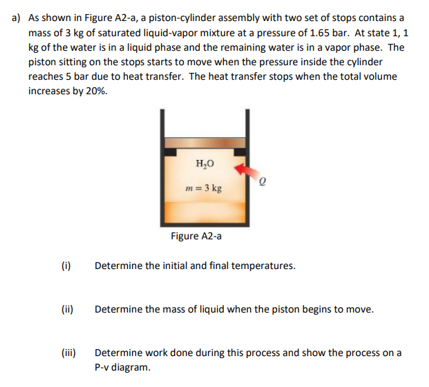As shown in Figure A2-a, a piston-cylinder assembly with two set of stops contains a mass of 3 kg of saturated liquid-vapor mixture at a pressure of 1.65 bar. At state 1, 1 kg of the water is in a liquid phase and the remaining water is in a vapor phase. The piston sitting on the stops starts to move when the pressure inside the cylinder reaches 5 bar due to heat transfer. The heat transfer stops when the total volume increases by 20%. H₂O m=3 kg Figure A2-a (i) Determine the initial and final temperatures. Determine the mass of liquid when the piston begins to move. Determine work done during this process and show the process on a P-v diagram. (iii)
As shown in Figure A2-a, a piston-cylinder assembly with two set of stops contains a mass of 3 kg of saturated liquid-vapor mixture at a pressure of 1.65 bar. At state 1, 1 kg of the water is in a liquid phase and the remaining water is in a vapor phase. The piston sitting on the stops starts to move when the pressure inside the cylinder reaches 5 bar due to heat transfer. The heat transfer stops when the total volume increases by 20%. H₂O m=3 kg Figure A2-a (i) Determine the initial and final temperatures. Determine the mass of liquid when the piston begins to move. Determine work done during this process and show the process on a P-v diagram. (iii)
Elements Of Electromagnetics
7th Edition
ISBN:9780190698614
Author:Sadiku, Matthew N. O.
Publisher:Sadiku, Matthew N. O.
ChapterMA: Math Assessment
Section: Chapter Questions
Problem 1.1MA
Related questions
Question

Transcribed Image Text:a) As shown in Figure A2-a, a piston-cylinder assembly with two set of stops contains a
mass of 3 kg of saturated liquid-vapor mixture at a pressure of 1.65 bar. At state 1, 1
kg of the water is in a liquid phase and the remaining water is in a vapor phase. The
piston sitting on the stops starts to move when the pressure inside the cylinder
reaches 5 bar due to heat transfer. The heat transfer stops when the total volume
increases by 20%.
H₂O
m = 3 kg
Figure A2-a
(i)
Determine the initial and final temperatures.
(ii)
Determine the mass of liquid when the piston begins to move.
(iii)
Determine work done during this process and show the process on a
P-v diagram.
Expert Solution
This question has been solved!
Explore an expertly crafted, step-by-step solution for a thorough understanding of key concepts.
Step by step
Solved in 3 steps with 3 images

Knowledge Booster
Learn more about
Need a deep-dive on the concept behind this application? Look no further. Learn more about this topic, mechanical-engineering and related others by exploring similar questions and additional content below.Recommended textbooks for you

Elements Of Electromagnetics
Mechanical Engineering
ISBN:
9780190698614
Author:
Sadiku, Matthew N. O.
Publisher:
Oxford University Press

Mechanics of Materials (10th Edition)
Mechanical Engineering
ISBN:
9780134319650
Author:
Russell C. Hibbeler
Publisher:
PEARSON

Thermodynamics: An Engineering Approach
Mechanical Engineering
ISBN:
9781259822674
Author:
Yunus A. Cengel Dr., Michael A. Boles
Publisher:
McGraw-Hill Education

Elements Of Electromagnetics
Mechanical Engineering
ISBN:
9780190698614
Author:
Sadiku, Matthew N. O.
Publisher:
Oxford University Press

Mechanics of Materials (10th Edition)
Mechanical Engineering
ISBN:
9780134319650
Author:
Russell C. Hibbeler
Publisher:
PEARSON

Thermodynamics: An Engineering Approach
Mechanical Engineering
ISBN:
9781259822674
Author:
Yunus A. Cengel Dr., Michael A. Boles
Publisher:
McGraw-Hill Education

Control Systems Engineering
Mechanical Engineering
ISBN:
9781118170519
Author:
Norman S. Nise
Publisher:
WILEY

Mechanics of Materials (MindTap Course List)
Mechanical Engineering
ISBN:
9781337093347
Author:
Barry J. Goodno, James M. Gere
Publisher:
Cengage Learning

Engineering Mechanics: Statics
Mechanical Engineering
ISBN:
9781118807330
Author:
James L. Meriam, L. G. Kraige, J. N. Bolton
Publisher:
WILEY